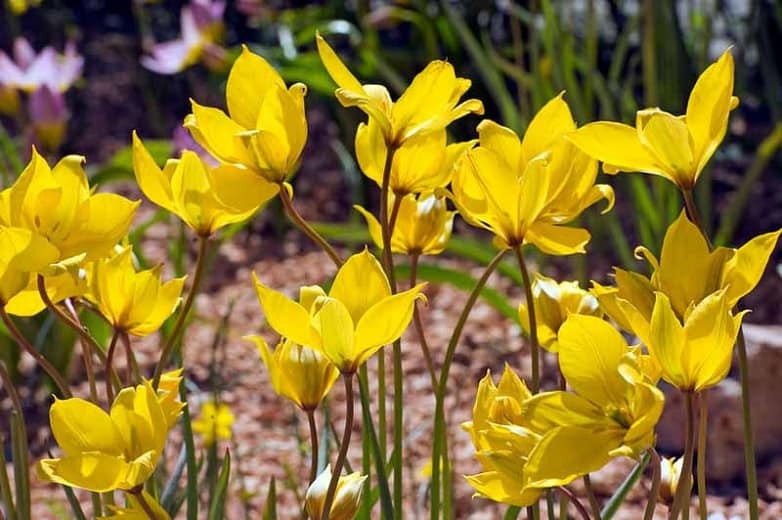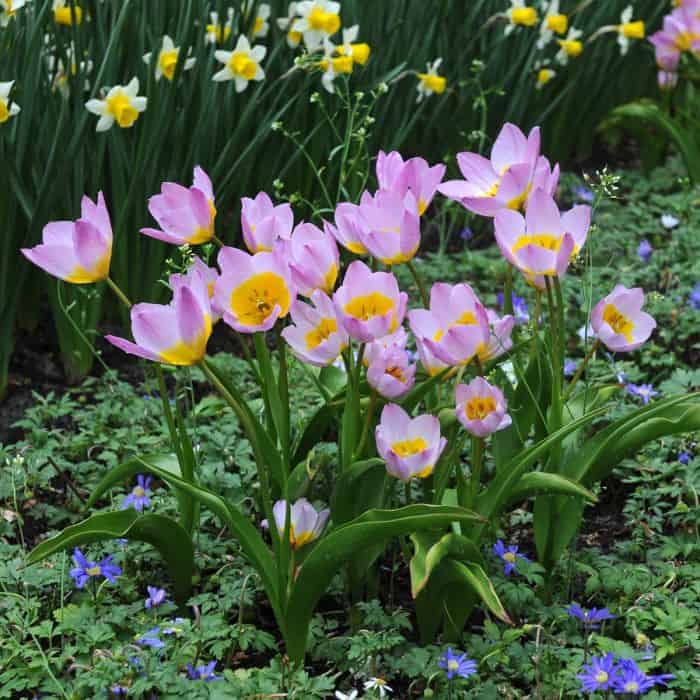As a gardener, I’ve learned a good lesson from tulips.
During my first venture into spring bulbs, I went straight for the iconic Dutch tulip. Tall and glamorous, Dutch tulips rise with a closed-fist shape and spring into action with a stunning burst of color like the undisputed Queens of Spring.
I planted Golden Apeldoorn tulips (above) in a circle around the base of our dogwood tree, and a flashmob of orange, pink, and rosy-red tulips at the high point of our front yard.
That spring my tulips bloomed with such dazzling force they brought passing joggers to a halt. But I paid a price.
Those Dutch divas were expensive and, as I learned the hard way, they didn’t appear the following season. Dutch hybrids are known for a first flush of beauty; equally notorious for refusing repeat performances.

Botanical Tulips can become perennials
When it comes to spring bulbs, naturalizing – or a plant’s ability to survive and increase – has become a priority for me. I want a garden to befriend and grow with over time. I want a real relationship, not flash-in-the-pan glamour.
This year I’ve planted botanical tulips.
Petite, wild, and sturdy, botanical or species tulips often return year after year to multiply, making them a good investment.
Smaller and wilder than hybrid tulips, they also sing through spring thunderstorms, appearing earlier and thriving in harsher conditions than their cultivated counterparts.
Botanical tulips naturalize by underground stolons, small bulblets, or seed-setting (unlike Dutch hybrid tulips, which are usually sterile and cannot multiply.)
I began by planting a single species of botanical tulip last year and, utterly charmed by the result, I’m adding more. My initial choice was Tulipa sylvestris, known as a woodland or Florentine tulip, which naturalizes here in the South.
Sylvestris proved to be a lovely, long-stemmed sprite, wild and sweet-smelling, with a sharp-petaled face that followed the sun in the springtime chill.
Here is Tulipa sylvestris below!

To welcome 2022 with delight, I’ve added Lilac Wonder, an 8-inch botanical beauty that unfurls in soft pink petals around a bright yellow face. The Lizzy tulip, a siren-red botanical tulip whose sharp star petals frame an alluring black center. And Little Princess, a dainty, scented botanical tulip with burnt red edges around a yellow-rimmed center.
My sincere hope is that these botanical tulips will claim my garden as their home and return again and again. I’ll report back about who thrives in my sunny, well-drained front walkway, and who fades away, unable to adapt to life in Asheville, NC.
Here’s Lilac Wonder below!

Nature as artist
During my first year of bulb mania, I planted the glamorous, highly-cultivated Dutch tulips in a showy parade facing the street. Now I find myself planting botanical bulbs in a more intimate pattern for my own pleasure.
I’ve placed them among the mazus groundcover that trails and drifts along the rocks leading to my door. This spring I hope they’ll pop forth in bright, boisterous cliques, beckoning me to bend down and gossip.
The more I garden, the more I turn from too much pomp and flash; showy gestures like that first grasp toward Dutch tulips.
The smaller, subtler beauty of the botanical tulip speaks to its wild origins, reminding me that nature’s artistry and intelligence are hard to improve upon.

